MEEPO V2 PLUS (SANYO) – A COMPREHENSIVE REVIEW
The Meepo V2 Plus is technically my third Meepo board. I was an owner of the original Meepo board when it came out, which I later upgraded to the 1.5. Getting my hands on a V2/V2 Plus generation board means I’ve had the pleasure of experiencing Meepo’s gradual rise to the top of the budget board hierarchy first hand. But is the V2/V2 Plus enough to keep Meepo at the top?
A TL;DR is available at the end of this review.
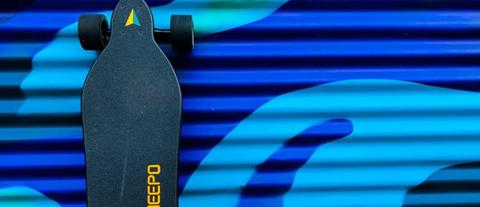
Let’s start by looking at what’s changed since the Meepo 1.5 (and the all-black 1.51). The key difference between the new generation of Meepo’s and the Meepo’s of old is the new ESC and remote combination.
The V2/V2 Plus ESC is a smaller and more refined design compared to the previous generation. It’s capable of a new, higher top speed of 25mph/40kph and comes paired with a revised and updated remote from the same original equipment manufacturer (OEM).
The ESC was further improved at the time of the V2 Plus’s release by fully enclosing the PCB inside of the enclosure, essentially making the ESC “double-enclosed.”
The new remote is the next iteration of the Winning/Nano clone remote that we’ve all become so familiar with. This version of the remote features a much better LED lighting system that double-functions as a battery level indicator and a speed mode indicator. This new generation remote also now features four speed modes (Beginner, Eco, Expert and Pro) as supposed to the previous generations three speed modes.
In addition, both trucks have been re-designed. The front truck has been engineered to be much stronger and is now closer to a Paris clone; departing from the previous Caliber II clone. The rear hanger length has also been changed so the width of the rear hub motors, end-to-end, matches that of the front wheels, providing a symmetrical footprint on the road.
Some smaller changes were also implemented when the V2/V2 Plus production run started to scale-up, such as a smaller logo, softer durometer wheels and several other minor tweaks that have now been mirrored across the entire Meepo range.
The only difference remaining that separates the V2 from the V2 Plus is the feature of easily replaceable urethane sleeves on the V2 Plus, which is not a feature on the non-Plus.
Both the V2 (non-Plus) board and multi-colored remote (that first came out with the V2 upon its launch) appear to be in the process of being phased out in favour of stocking only the V2 Plus with a matte black remote in foreseeable future.
THE SPEC SHEET
The Meepo V2/V2 Plus claims a top speed of 25mph/40kph and a claimed range of 11mi/17.7km with the standard (Samsung 20R 4.0Ah) battery or 17mi/27.3km with the upgraded “Tesla” (Sanyo 20700B 8.1Ah) battery. Both battery packs are 10s2p. The claimed hill gradient capability is 30%, which I think might be a bit of a stretch.
The 90mm hub motors are the typical 250W, 30-42V numbers that we’ve become accustomed to seeing in this category of boards. These motors have already been proven to pack a surprisingly large amount of torque and power.
THE HARDWARE
The same, all Canadian maple 38 inch deck we’re familiar with from the all-black 1.51 remains in place for the V2/V2 Plus, as does the familiar “Boosted-style” split enclosure system. The same power and drivetrain is also available in a 41 inch double-kicktail option as well as a 30 inch shortboard option.
The 38 inch deck maintains the comfortable concave implemented for the 1.5 and retains the same level of flex, which is a low/low-medium flex profile.
THE LOOK AND FEEL
Put the remote in your pocket and the V2 looks no different to the all-black 1.51. Look closely at the V2 Plus and the logos on the hub motor covers (that hold the urethane sleeves in place) become apparent. To notice any of the other subtle differences I mentioned during the opening of this review, you’d need to take the time to have a much closer look!
Like the all-black 1.51, the V2/V2 Plus looks like a complete and polished product. The all-black deck certainly elevates the look of the board into something more premium-looking. The embossed enclosures and build number of the board are nice touches too. I also certainly appreciate the reduced size of the logo on the grip tape.
Meepo have come a long way in very short space of time. These boards no longer look “budget,” that’s for sure!
The flex profile of the deck is what you’d expect considering its construction, shape and price-point. It’s no Loaded Vanguard, but a passable amount of flex is there to help make the ride just comfortable enough for commuting.
All-in-all the board feels well-balanced and comfortable. Even with the Sanyo 8.1Ah battery pack installed the board only weighs 17.8lbs/8.1kg according to my scales. Together with the handle built-in to the deck, it makes for an all-round convenient and fairly light’ish package.
To further enhance the comfort and carving quality of the board, I immediately installed a set of Orangatang Nipple bushings (purple/medium/87a). I was happy to find that the kingpin was long enough to accommodate a full double-barrel setup on the V2 Plus’s trucks.
I also threw some Bones Race Reds bearings on the front wheels for good measure.
If you invest in nothing else to help improve the feel of your board, invest in a good set of bushings. Trust me! Some ashtray money spent on a set of Nipple’s turns the board into something that feels like it should have easily cost twice as much!
These boards tend to become gateway, semi-DIY projects in the community. Many people continue to go much further by doing deck-swaps (as people have since the 1.0), changing the stock (front) wheels over to some genuine Californian urethane and/or even upgrading their front trucks to genuine Paris, Gullwing or even Avenue alternatives.
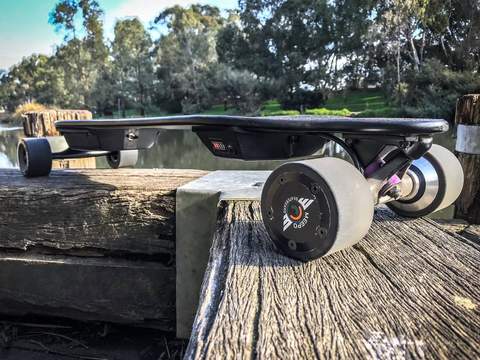

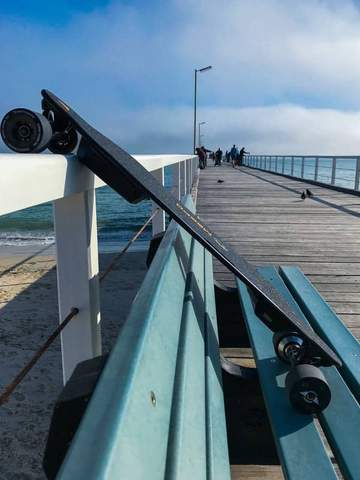
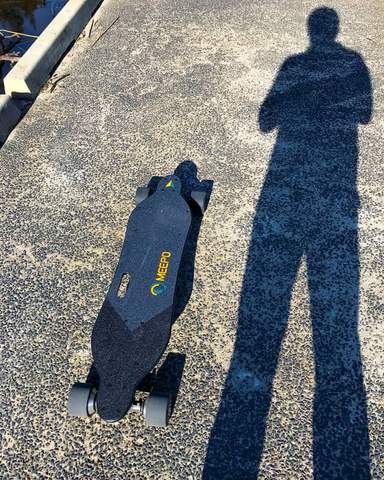
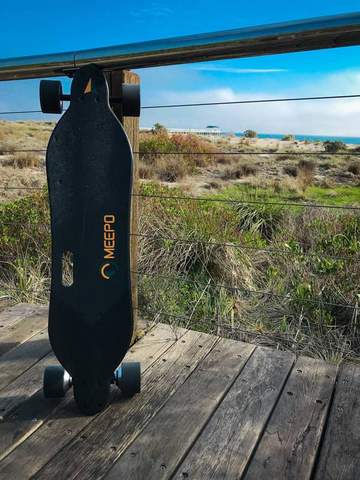
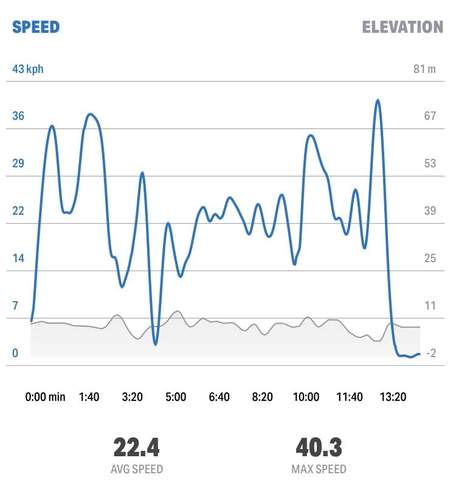

PERFORMANCE: V2 Plus vs. 1.5; Sanyo 8.1Ah vs. Samsung 4.0Ah
These are the results of my real-world performance tests with accompanying commentary.
For the top speed test I’m going to compare the highest achievable top speed of my V2 Plus to the top speed of my 1.5. This directly compares the new V2/V2 Plus ESC to the old 1.0/1.5 ESC.
For the range test I’m going to compare the real-world range of the Sanyo 20700B (8.1Ah) battery pack with the real-world range of the Samsung 20R 18650 (4.0Ah) battery pack.
For this section please note that I weigh about 198lbs/90kg these days and I ride flat-out as often as possible.
Top Speed:
Meepo V2 Plus = 25.04mph/40.3kph in Pro mode
Meepo 1.5 = 22.8mph/36.7kph in the highest speed mode
The new V2/V2 Plus ESC is 2.24mph/3.6kph faster (top speed) than the previous 1.0/1.5 ESC. It’s super impressive that Meepo continues to achieve their advertised top speed in the real-world (they always have).
Range:
Sanyo 8.1Ah = 12.05mi/19.4km blended riding in Expert/Pro mode
Samsung 4.0Ah = 8.2mi/13.3km in the highest speed mode
The Meepo website claims an additional 6.2mi/10km range with the Sanyo battery. However, this is with Keiran as the test rider. Keiran weighs somewhere in realms of 165lbs/75kg. I’m a bit heavier. I only achieved an additional 3.85mi/6.2km with the Sanyo pack. This was with blended mode riding. On straight and flat bitumen (and a few mild hills) I was in Pro mode, but when I had to take care to navigate some of the trickier areas of my route (and for about the last 35% of my ride generally), I was in Expert mode.
Hill Climbing: I took the Meepo V2 Plus (Sanyo) to my local test incline of 15.7% on about 50% battery and it still killed it at nearly full speed (Pro mode)! It would take being below 25% battery and a 20+% incline to have a chance of slowing the board down. However, I do believe the claims of a 30% hill grade capability to be a little bloated. If true, it would have to be a featherweight human on a full battery with a 300m run-up, chewing up half of your battery in the process. Even then…
Sag: The Samsung 4.0Ah battery starts to sag in around the last 15% of its charge. Frankly, I experienced about the same with the Sanyo 8.1Ah battery. Both packs are very good regarding the late onset of battery sag, but the claim of zero (or near zero) battery sag regarding the Sanyo battery is a little exaggerated.
HIGHLIGHTS AND LOWLIGHTS (one, the other, or both)
Traditional Meepo features (highlights): Smart turn on will never get old and is a feature not available with all of the competitors. When I ride other boards without handles these days, I miss them. I blame Meepo for this.
The new remote (both): Although I was a fan (one of a few) of the previous remote, I will happily concede that the new remote is definitely an improvement in terms of quality, ergonomics and functionality. However, I’m not entirely sure it improved enough in the areas that needed it most. The new LED system is fantastic and vastly superior to its nearest rival, but the throw/travel of the throttle and brake roller is about the same as the previous remote, which really could have done with a couple of extra mm either side.
Pro mode (both): The new ESC’s forth speed mode and higher top speed has simultaneously made this board both slower and faster than its predecessor. Let me explain: Yes, the Meepo V2/V2 Plus does indeed reach a higher top speed than the 1.5 and even its current competitors, but by spreading the available performance over four speed modes it also weakens the performance of each mode. Thus, the first three speed modes (Beginner, Eco and Expert) all feel comparatively lower in performance compared to the Meepo 1.5. Only the fourth speed mode (Pro) delivers a level of performance close to what previous and current Meepo 1.5 riders are familiar with.
There’s a couple of points of view to consider here. One is that the V2/V2 Plus is a backwards step in bottom end performance compared to the 1.5, but the counter-argument is that the V2/V2 Plus still performs better in both bottom and top end performance when compared to its nearest competitors. Another way to look at it is that the Meepo is now more beginner friendly than it ever has been. The first three speed modes are gradual, smooth and make for an easy introduction to esk8ing for beginners. Expert (and to a lesser extent, Eco) are also great cruising modes. I’d be pretty disappointed though if that’s all there was. If Meepo was reduced to a “beginners only” board by curtailing the modes too far towards the “gentle” end of the spectrum, I’d have to concede to calling the V2/V2 Plus neutered compared to the 1.5. But alas, Pro mode exists, and although its existence cuts the first three modes off at the knees, it redeems things in the fourth!
Value for money (highlight): It’s hard to fault what you get for your money here. A 38 inch V2 Plus isn’t just a sub-$500 USD board, it’s damn near a sub-$400 USD ($419 USD) board at the time of writing this, which includes delivery to most countries!
Deck (lowlight): Despite the deck being vastly improved since the days of the convex 1.0, the sheer amount of people still doing deck swaps suggests improvements can still be made here. I agree. There needs to be a little more rebound. Re-introduce a bit of bow/arch to the deck, or even better, introduce an optional bamboo deck upgrade at the point of purchase and it will improve the board ten-fold.
Braking (lowlight): Almost all braking is more aggressive at low speed in the world of esk8, but the V2/V2 Plus ESC is particularly noticeable in this regard.
Micro-seizures (lowlight): I mentioned this during my 1.0 to 1.5 review. These micro-seizures still seem to be a persistent issue, even with the new ESC. I will say, however, they appear to be softer, less intrusive/abrupt and less frequent. Why they occur at all is a matter the OEM needs to look into as a matter of priority.
CONCLUSION/TL;DR
Once upon a time getting a board at this price-point meant sacrificing a lot, be that having to accept a crappy deck, non-replaceable urethanes, a sub-par remote, laughable top speed, pitiful range or ride-crippling battery sag once you hit the 50% mark. With all of the improvements made from the original Meepo right through to the V2 Plus, now you’re not sacrificing much of anything at all! A deck swap might still be on the cards for some, but this hasn’t been “essential” since the 1.5. The new generation of Meepo boards arrive on your doorstep as complete and polished products right out of the box!
With that in mind, I find a board this feature-packed and spec-rich at such a low price-point hard to fault. Yes, there are still some grey areas regarding overall durability, reliability and longevity worth pointing out, but it all has to be taken into account in light of the budget price tag. If the durability, reliability and longevity question marks were to be put to rest with Boosted-level solutions, then you’d forgive Meepo for starting to charge something close Boosted-level prices. The price is lower here for a reason…
My Meepo V2 Plus (Sanyo) performed to my expectations with regards to top speed, range (there or thereabouts) and hill climbing. The Sanyo battery isn’t, however, “sag-less” and the new generation ESC removes a lot of performance from the first three speed modes and saves all of it almost exclusively for the forth (Pro) speed mode.
Is the Sanyo 8.1Ah battery worth the cost? Well, it’s only an extra $180 USD to upgrade to the Sanyo battery at the point of purchase. $180 USD for 4 more miles/6 more km (which will increase the lighter you are and the less aggressively you ride) and a much, much longer shelf-life! In my opinion the extra $180 USD is worth it for the shelf-life alone; up to 3000 cycles compared to the Samsung’s 300 cycles, plus you get a bit of extra range as a bonus. The cost of $255 USD as a separate purchase is a little harder to justify. If you’re going to do it, do it straight-up.
Meepo continues to offer solid, entry-level esk8 options with the V2/V2 Plus generation of boards, particularly with how cruisy the first three speed modes are now. It’s also a solid board for someone looking for a Boosted alternative (Pro mode is for you) without the price tag, but is willing to trade proprietary parts for generic ones, belts for hubs and a difference in durability, reliability and longevity in-keeping with the difference in price.
